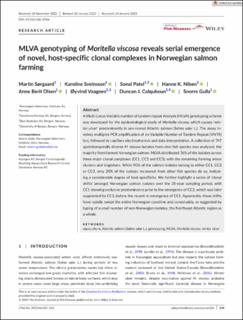| dc.contributor.author | Sørgaard, Martin | |
| dc.contributor.author | Sveinsson, Karoline Overn | |
| dc.contributor.author | Patel, Sonal | |
| dc.contributor.author | Nilsen, Hanne Katrine | |
| dc.contributor.author | Olsen, Anne Berit | |
| dc.contributor.author | Vaagnes, Øyvind | |
| dc.contributor.author | Colquhoun, Duncan John | |
| dc.contributor.author | Gulla, Snorre | |
| dc.date.accessioned | 2023-08-10T08:39:44Z | |
| dc.date.available | 2023-08-10T08:39:44Z | |
| dc.date.created | 2023-05-03T13:58:59Z | |
| dc.date.issued | 2023 | |
| dc.identifier.issn | 0140-7775 | |
| dc.identifier.uri | https://hdl.handle.net/11250/3083300 | |
| dc.description.abstract | A Multi-Locus Variable number of tandem repeat Analysis (MLVA) genotyping scheme was developed for the epidemiological study of Moritella viscosa, which causes ‘winter ulcer’ predominantly in sea-reared Atlantic salmon (Salmo salar L.). The assay involves multiplex PCR amplification of six Variable Number of Tandem Repeat (VNTR) loci, followed by capillary electrophoresis and data interpretation. A collection of 747 spatiotemporally diverse M. viscosa isolates from nine fish species was analysed, the majority from farmed Norwegian salmon. MLVA distributed 76% of the isolates across three major clonal complexes (CC1, CC2 and CC3), with the remaining forming minor clusters and singletons. While 90% of the salmon isolates belong to either CC1, CC2 or CC3, only 20% of the isolates recovered from other fish species do so, indicating a considerable degree of host specificity. We further highlight a series of ‘clonal shifts’ amongst Norwegian salmon isolates over the 35-year sampling period, with CC1 showing exclusive predominance prior to the emergence of CC2, which was later supplanted by CC3, before the recent re-emergence of CC1. Apparently, these shifts have rapidly swept the entire Norwegian coastline and conceivably, as suggested by typing of a small number of non-Norwegian isolates, the Northeast Atlantic region as a whole. | en_US |
| dc.language.iso | eng | en_US |
| dc.publisher | Wiley | en_US |
| dc.rights | Navngivelse 4.0 Internasjonal | * |
| dc.rights.uri | http://creativecommons.org/licenses/by/4.0/deed.no | * |
| dc.title | MLVA genotyping of Moritella viscosa reveals serial emergence of novel, host-specific clonal complexes in Norwegian salmon farming | en_US |
| dc.type | Journal article | en_US |
| dc.type | Peer reviewed | en_US |
| dc.description.version | publishedVersion | en_US |
| dc.rights.holder | Copyright 2023 The Authors. | en_US |
| cristin.ispublished | true | |
| cristin.fulltext | original | |
| cristin.qualitycode | 1 | |
| dc.identifier.doi | 10.1111/jfd.13766 | |
| dc.identifier.cristin | 2145160 | |
| dc.source.journal | Journal of Fish Diseases | en_US |
| dc.source.pagenumber | 535-543 | en_US |
| dc.identifier.citation | Journal of Fish Diseases. 2023, 46 (5), 535-543. | en_US |
| dc.source.volume | 46 | en_US |
| dc.source.issue | 5 | en_US |

